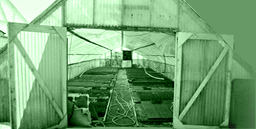by Mike Braunlich
Last updated: November 28, 2004
Dioscorea elephantipes often takes a few months to get acclimated to a new home,
but it is a fairly easy plant to grow as long as you follow a few basic rules.
We ship our plants slightly on the dry side, so make sure and water your plant throughly when you receive it.
 Ideal temperature
Ideal temperature
Keep the plant above 60ºF, inside or outside.
If it drops to 55ºF for a few days, it's not a problem, but prolonged low temperatures will affect the plant adversely.
 Watering
Watering
Don't let the soil fully dry out as the roots will begin to die.
Even when there is no vine, the plant should not be kept completely dry.
Once you see a vine actively growing, increase the water.
 Fertilizer
Fertilizer
Dioscorea elephantipes likes light fertilizer when its vine is actively growing.
Don't use full-strength fertilizer -- the Dioscorea will not like it.
If you use a liquid fertilizer, dilute it by 50% or more.
If you do this you can fertilize every few weeks when the vine is growing.
You can never tell when the plant wishes to send out a new vine.
The vine may start growing right away or the plant might just sit there and sulk for a bit.
 Repotting
Repotting
We ship the plants potted so you should not need to repot it for at least a year.
When you do repot it, use a good general-purpose potting soil and add perlite to it so the soil drains better.
Adding 20-25% perlite to a peat- or bark-based potting soil will give good results.
If you grow these plants in peat, the chances of the caudex rotting out would be greatly increased.
The caudex will grow faster if it's kept partially to completely buried, although you might like the look of the exposed caudex.
Once the caudex gets to about 1.5 inches in diameter, you should start seeing the fissured appearance.
 Dormancy
Dormancy
When the leaves start turning brown or yellow on the edges, you will know that the plant is thinking about going into a dormant phase.
There is not much rhyme nor reason to when they are going dormant, so you just need to keep observing the plant.
For example, in the Seattle area, my plants go through dormancy several times every year.
 Pruning
Pruning
I trim the vines all the way back several times per year, whenever the plant decides to go dormant.
After I trim the vines back, the plant generally sends out another vine within 2-4 weeks (sometimes longer in the winter).
Some people rarely trim the vine back, but I like to see fresh, new foliage.
However, if you have a small plant, it's best to be in no hurry to trim the vine back.
As long as the vine is growing, the caudex is getting bigger.
Feel free to contact us with further questions at
info@terrapin-gardens.com.


